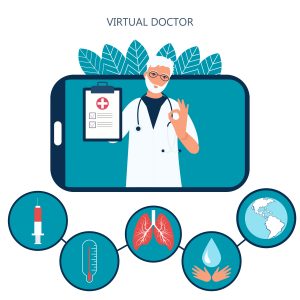Estimated reading time: 3 minutes
Nearly every region in the United States of America has received different regulations and mandates to abide by, in hopes of clearing the COVID-19 virus from their midst and flattening the curve of those infected by the virus. Among those regulations, many have been advised to work-from-home if possible, keep a 6-feet distance from strangers, and wear a mask when venturing out into the public. Adding to that, various technology software companies are entering the equation to provide the world with solutions to help ease the pain and stop the spread.
 We all know that Telemedicine came into the picture at a time when it was needed most, so it’s fair to say that remote doctors’ visits are here to stay and will likely be built upon in the future. At the same time, those manufacturers with the ability to access 3D printers and larger industrial-scale machines are striving to meet the need for ventilators, face masks, and breathing filters to better fulfill the medical community’s need.
We all know that Telemedicine came into the picture at a time when it was needed most, so it’s fair to say that remote doctors’ visits are here to stay and will likely be built upon in the future. At the same time, those manufacturers with the ability to access 3D printers and larger industrial-scale machines are striving to meet the need for ventilators, face masks, and breathing filters to better fulfill the medical community’s need.
IoT Steps up to Bat
The Internet of Things has already found itself useful amongst medical professionals and healthcare providers in previous times, but it’s increasingly taking on new responsibilities when it comes to battling this novel pandemic. From tracking individuals in quarantine, pre-screening those with pre-existing conditions, cleaning and disinfecting equipment, and implementing drones into primary care have all become apart of the “new normal” throughout these past couple of months. Many doctors and administrative officials are even referring to smart maps where case numbers and infection percentages are stored to analyze the change of the nation and which regions are likely most at risk.
Sticking to Mobile Connections
Whether it’s found intentional or not, many of us refer to our mobile phones for a quick Google search or a scroll through social media to fact-check claims. With mobile apps and devices becoming a crutch for individuals, especially the younger generations, there is a lot that could be marketed their way to help spread the word, and event effectively communicate signs and symptoms for the virus, to keep people in the know.
The CDC, White House, and the Federal Emergency Management Agency (FEMA) have all partnered up with Apple to compile and distribute relevant information from trusted sources, teaching users how to effectively observe hand-washing and hygienic practices, social distancing recommendations, tips and tricks for participating in quarantine, cleaning and disinfecting commonly visited and frequented locations, and so much more. Whether this content has been integrated into one’s tele-health/tele-medicinal apps or just found organically, such communications are key right now, especially in the midst of this chaos.
Artificial Intelligence Hopping on Board
AI applications are keeping a lookout during this pandemic. With the help of Natural Language Processing (NLP), AI is able to identify, track, trace and scan for breakouts based on location-based data and those who are complying with the recommended guidelines and mandates. In addition, AI is able to collectively analyze specific data points to predict where hotspots may occur and use that prediction to take more proactive steps in the future.
 Researchers and hospitals are utilizing CT scans, chest X-Rays, and lung ultrasound images to help craft out a predictive AI model to support the treatment of COVID-19 patients. This is done at various academic facilities, including Stanford University, Ohio State University, University of Pennsylvania, and Emory University. In one case, in particular, AI was able to detect signs of pneumonia in a patient who wasn’t experiencing a symptoms at all, but then tested positive for COVID-19. Scientists say the largest challenge with AI is finding out how to implement such algorithms, when each instance has its varying conditions and factors. No patient is the same and exhibits the same symptoms.
Researchers and hospitals are utilizing CT scans, chest X-Rays, and lung ultrasound images to help craft out a predictive AI model to support the treatment of COVID-19 patients. This is done at various academic facilities, including Stanford University, Ohio State University, University of Pennsylvania, and Emory University. In one case, in particular, AI was able to detect signs of pneumonia in a patient who wasn’t experiencing a symptoms at all, but then tested positive for COVID-19. Scientists say the largest challenge with AI is finding out how to implement such algorithms, when each instance has its varying conditions and factors. No patient is the same and exhibits the same symptoms.
In conclusion, the Coronavirus Pandemic has proved to be a real-life horror story for all of us. Whether you’ve been furloughed and are awaiting unemployment payments or know someone who has contracted the virus and have battled with it, 2020 has been an unpredictable year, with jump scares around every corner. The virus has caused a world of hurt for so many, but technology innovators have been there to provide an answer to all of the issues taking place. If you’re interested in learning more about what BlueStar is doing to fight COVID-19, be sure to visit our COVID-19 Solutions Page, to see how all of our vendors are standing up to this infectious virus.

